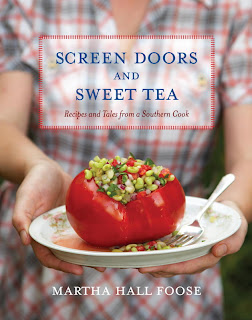
Screen Doors And Sweet Tea
By Martha Hall Foose
By Martha Hall Foose
"Books offered alternative adventures to me as I grew up amid the kudzu. Mrs. Wilburn would read aloud to our fourth-grade class each morning from Willie Morris's books. We hung on every words, sending up a sorrowful "awww" when she would leave us hanging until the next day. For the first time I realized that a book could be about where you were from. Until then they had been about fairy-tale kindoms or tales of old or distant places cover by National Geographic. Later the lovely Bea Donnelly, Dean of Girls at high school, introduced me to Faulkner's story "The Bear," and my love of books about the South became firmly rooted."
--Author quote.
Publishers Weekly - The warm, languid air of the South filters through this engaging book, in which Foose shares the traditional recipes that she ate while growing up on the Mississippi Delta and has returned to after training as a pastry chef in France and traveling the world. Gently humorous stories about family and friends form a seamless part of her instructions for community recipes like Strawberry Missionary Society Salad, as well as pleasant surprises like Tabbouleh, Curried Sweet Potato Soup, and Chinese Grocery Roast Pork that take Southern food beyond stereotypes. Fried chicken and grits do appear, but for such classics Foose emphasizes relatively simple, wholesome preparations that are rich without loading on more butter and oil than necessary. Although recipes for Gumbo Z’Herbs, Chile Lime Skirt Steak, and creamy succotash are mouthwatering enough just to read about, many cooks will be tempted to flip straight to the last chapters, where her enticing breads and pastries provide the book with a winning flourish. The cook may be Southern, but the appeal of the dishes she presents should reach well beyond people who grew up in the land of four-hour lunches and sweet tea savored on a porch swing.
--Author quote.
Publishers Weekly - The warm, languid air of the South filters through this engaging book, in which Foose shares the traditional recipes that she ate while growing up on the Mississippi Delta and has returned to after training as a pastry chef in France and traveling the world. Gently humorous stories about family and friends form a seamless part of her instructions for community recipes like Strawberry Missionary Society Salad, as well as pleasant surprises like Tabbouleh, Curried Sweet Potato Soup, and Chinese Grocery Roast Pork that take Southern food beyond stereotypes. Fried chicken and grits do appear, but for such classics Foose emphasizes relatively simple, wholesome preparations that are rich without loading on more butter and oil than necessary. Although recipes for Gumbo Z’Herbs, Chile Lime Skirt Steak, and creamy succotash are mouthwatering enough just to read about, many cooks will be tempted to flip straight to the last chapters, where her enticing breads and pastries provide the book with a winning flourish. The cook may be Southern, but the appeal of the dishes she presents should reach well beyond people who grew up in the land of four-hour lunches and sweet tea savored on a porch swing.



